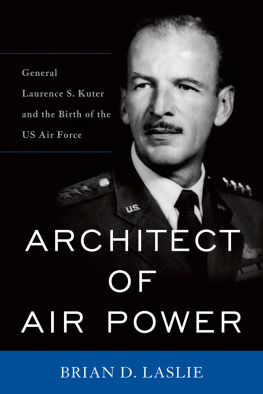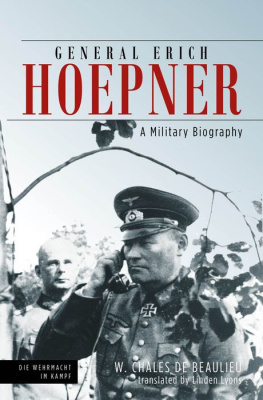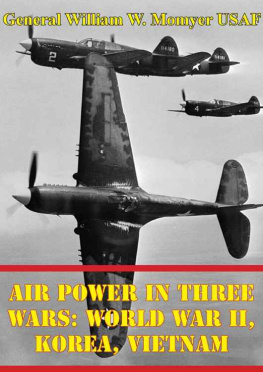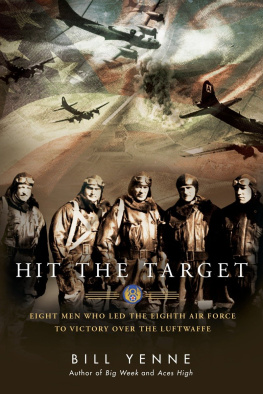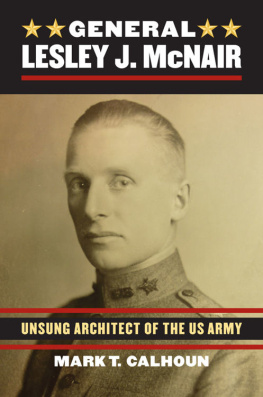Brian D. Laslie - Architect of Air Power: General Laurence S. Kuter and the Birth of the US Air Force
Here you can read online Brian D. Laslie - Architect of Air Power: General Laurence S. Kuter and the Birth of the US Air Force full text of the book (entire story) in english for free. Download pdf and epub, get meaning, cover and reviews about this ebook. year: 2017, publisher: The University Press of Kentucky, genre: Non-fiction. Description of the work, (preface) as well as reviews are available. Best literature library LitArk.com created for fans of good reading and offers a wide selection of genres:
Romance novel
Science fiction
Adventure
Detective
Science
History
Home and family
Prose
Art
Politics
Computer
Non-fiction
Religion
Business
Children
Humor
Choose a favorite category and find really read worthwhile books. Enjoy immersion in the world of imagination, feel the emotions of the characters or learn something new for yourself, make an fascinating discovery.
- Book:Architect of Air Power: General Laurence S. Kuter and the Birth of the US Air Force
- Author:
- Publisher:The University Press of Kentucky
- Genre:
- Year:2017
- Rating:4 / 5
- Favourites:Add to favourites
- Your mark:
Architect of Air Power: General Laurence S. Kuter and the Birth of the US Air Force: summary, description and annotation
We offer to read an annotation, description, summary or preface (depends on what the author of the book "Architect of Air Power: General Laurence S. Kuter and the Birth of the US Air Force" wrote himself). If you haven't found the necessary information about the book — write in the comments, we will try to find it.
At age 36, Laurence S. Kuter (19051979) became the youngest general officer since William T. Sherman. He served as deputy commander of allied tactical air forces in North Africa during World War II and helped devise the American bombing strategy in Europe. Although his combat contributions were less notable than other commanders in the Eighth Air Force, few officers saw as many theaters of operation as he did or were as highly sought-after. After World War II, he led the Military Air Transport Service, Air University, Far East Air Forces, and served as commander-in-chief of the North American Air Defense Command (NORAD). Despite these accomplishments and others, however, Kuter remains widely underappreciated.
In Architect of Air Power, Brian D. Laslie offers the first biography of this important but unsung pioneer whose influence can be found in every stage of the development of an independent US Air Force. From his early years at West Point to his days at the Air Corps Tactical School to his leadership role at NORAD, Kuter made his mark with quiet efficiency. He was an early advocate of strategic bombardment rather than pursuit or fighter aviation?fundamentally changing the way air power was used?and later helped implement the Berlin airlift in 1948. In what would become a significant moment in military history, he wrote Field Manual 100-20, which is considered the Air Forces declaration of independence from the Army.
Drawing on diaries, letters, and scrapbooks, Laslie offers a complete portrait of this influential soldier. Architect of Air Power illuminates Kuters pivotal contributions and offers new insights into critical military policy and decision-making during the Second World War and the Cold War.
Praise for Architect of Air Power
Laslie expertly brings into focus perhaps the least known of the major Air Force personalities of World War II and the early Cold War. Kuter was the indispensable behind-the-scenes man in those years, and this book fills a similarly indispensable gap in our understanding of the people and ideas that propelled the nations air arm to independence and prominence. Thomas Alexander Hughes, author of Over Lord: General Pete Quesada and the Triumph of Tactical Air Power in World War II
Laslies outstanding work on Laurence Kuter is the first full and highly effective look at this exceptionally important airman. It gives the reader ample evidence of Kuters central role in making America the quintessential airpower nation during the course of the twentieth century. This will be the book on Kuter for many years to come. Robert S. Ehlers, Jr., author of The Mediterranean Air War: Airpower and Allied Victory in World War II
Brian D. Laslie: author's other books
Who wrote Architect of Air Power: General Laurence S. Kuter and the Birth of the US Air Force? Find out the surname, the name of the author of the book and a list of all author's works by series.

